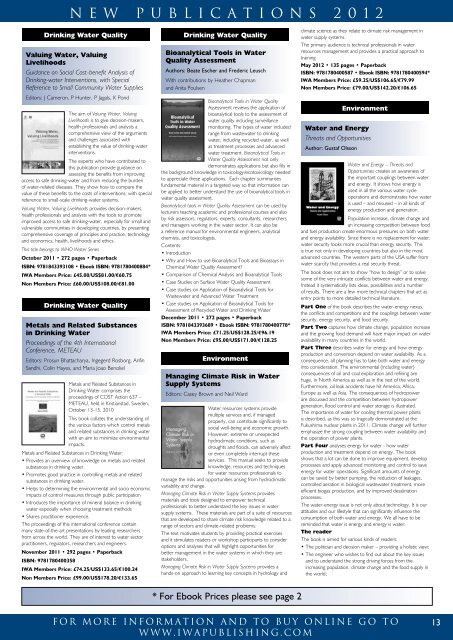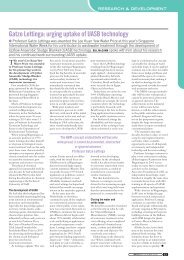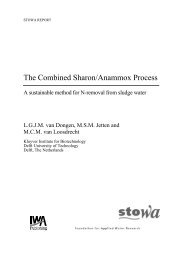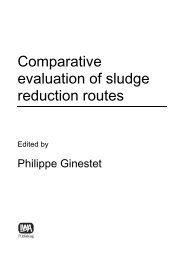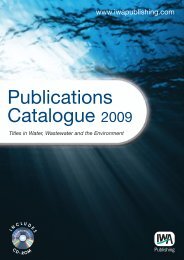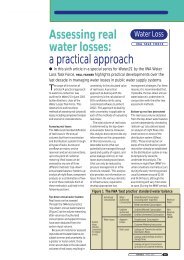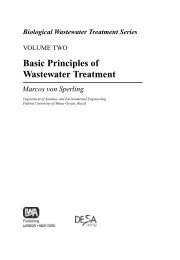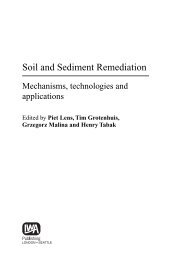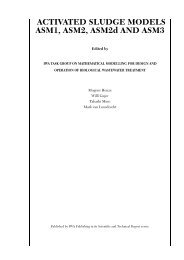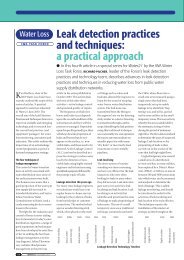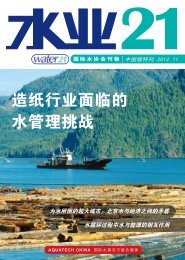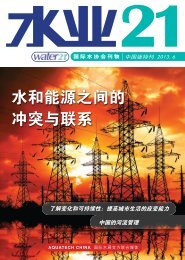PUBLICATIONS CATALOGUE 2012 - IWA Publishing
PUBLICATIONS CATALOGUE 2012 - IWA Publishing
PUBLICATIONS CATALOGUE 2012 - IWA Publishing
Create successful ePaper yourself
Turn your PDF publications into a flip-book with our unique Google optimized e-Paper software.
N E W P U B L I C A T I O N S 2 0 1 2<br />
Drinking Water Quality<br />
Valuing Water, Valuing<br />
Livelihoods<br />
Guidance on Social Cost-benefit Analysis of<br />
Drinking-water Interventions, with Special<br />
Reference to Small Community Water Supplies<br />
Editors: J Cameron, P Hunter, P Jagals, K Pond<br />
The aim of Valuing Water, Valuing<br />
Livelihoods is to give decision-makers,<br />
health professionals and analysts a<br />
comprehensive view of the arguments<br />
and challenges associated with<br />
establishing the value of drinking-water<br />
interventions.<br />
The experts who have contributed to<br />
this publication provide guidance on<br />
assessing the benefits from improving<br />
access to safe drinking-water and from reducing the burden<br />
of water-related diseases. They show how to compare the<br />
value of these benefits to the costs of interventions, with special<br />
reference to small-scale drinking-water systems.<br />
Valuing Water, Valuing Livelihoods provides decision-makers,<br />
health professionals and analysts with the tools to promote<br />
improved access to safe drinking-water, especially for small and<br />
vulnerable communities in developing countries, by presenting<br />
comprehensive coverage of principles and practice, technology<br />
and economics, health, livelihoods and ethics.<br />
This title belongs to WHO Water Series<br />
October 2011 • 272 pages • Paperback<br />
ISBN: 9781843393108 • Ebook ISBN: 9781780400884*<br />
<strong>IWA</strong> Members Price: £45.00/US$81.00/e60.75<br />
Non Members Price: £60.00/US$108.00/e81.00<br />
Drinking Water Quality<br />
Metals and Related Substances<br />
in Drinking Water<br />
Proceedings of the 4th International<br />
Conference, METEAU<br />
Editors: Prosun Bhattacharya, Ingegerd Rosborg, Arifin<br />
Sandhi, Colin Hayes, and Maria Joao Benoliel<br />
Metals and Related Substances in<br />
Drinking Water comprises the<br />
proceedings of COST Action 637 –<br />
METEAU, held in Kristianstad, Sweden,<br />
October 13-15, 2010<br />
This book collates the understanding of<br />
the various factors which control metals<br />
and related substances in drinking water<br />
with an aim to minimize environmental<br />
impacts.<br />
Metals and Related Substances in Drinking Water:<br />
• Provides an overview of knowledge on metals and related<br />
substances in drinking water.<br />
• Promotes good practice in controlling metals and related<br />
substances in drinking water.<br />
• Helps to determining the environmental and socio‐economic<br />
impacts of control measures through public participation<br />
• Introduces the importance of mineral balance in drinking<br />
water especially when choosing treatment methods<br />
• Shares practitioner experience.<br />
The proceedings of this international conference contain<br />
many state-of-the-art presentations by leading researchers<br />
from across the world. They are of interest to water sector<br />
practitioners, regulators, researchers and engineers.<br />
November 2011 • 292 pages • Paperback<br />
ISBN: 9781780400358<br />
<strong>IWA</strong> Members Price: £74.25/US$133.65/e100.24<br />
Non Members Price: £99.00/US$178.20/e133.65<br />
Drinking Water Quality<br />
Bioanalytical Tools in Water<br />
Quality Assessment<br />
Authors: Beate Escher and Frederic Leusch<br />
With contributions by Heather Chapman<br />
and Anita Poulsen<br />
Bioanalytical Tools in Water Quality<br />
Assessment reviews the application of<br />
bioanalytical tools to the assessment of<br />
water quality including surveillance<br />
monitoring. The types of water included<br />
range from wastewater to drinking<br />
water, including recycled water, as well<br />
as treatment processes and advanced<br />
water treatment. Bioanalytical Tools in<br />
Water Quality Assessment not only<br />
demonstrates applications but also fills in<br />
the background knowledge in toxicology/ecotoxicology needed<br />
to appreciate these applications. Each chapter summarises<br />
fundamental material in a targeted way so that information can<br />
be applied to better understand the use of bioanalytical tools in<br />
water quality assessment.<br />
Bioanalytical tools in Water Quality Assessment can be used by<br />
lecturers teaching academic and professional courses and also<br />
by risk assessors, regulators, experts, consultants, researchers<br />
and managers working in the water sector. It can also be<br />
a reference manual for environmental engineers, analytical<br />
chemists, and toxicologists.<br />
Contents:<br />
• Introduction<br />
• Why and How to use Bioanalytical Tools and Bioassays in<br />
Chemical Water Quality Assessment?<br />
• Comparison of Chemical Analysis and Bioanalytical Tools<br />
• Case Studies on Surface Water Quality Assessment<br />
• Case studies on Application of Bioanalytical Tools for<br />
Wastewater and Advanced Water Treatment<br />
• Case studies on Application of Bioanalytical Tools for<br />
Assessment of Recycled Water and Drinking Water<br />
December 2011 • 272 pages • Paperback<br />
ISBN: 9781843393689 • Ebook ISBN: 9781780400778*<br />
<strong>IWA</strong> Members Price: £71.25/US$128.25/e96.19<br />
Non Members Price: £95.00/US$171.00/e128.25<br />
Environment<br />
Managing Climate Risk in Water<br />
Supply Systems<br />
Editors: Casey Brown and Neil Ward<br />
Water resources systems provide<br />
multiple services and, if managed<br />
properly, can contribute significantly to<br />
social well-being and economic growth.<br />
However, extreme or unexpected<br />
hydroclimatic conditions, such as<br />
droughts and floods, can adversely affect<br />
or even completely interrupt these<br />
services. This manual seeks to provide<br />
knowledge, resources and techniques<br />
for water resources professionals to<br />
manage the risks and opportunities arising from hydroclimatic<br />
variability and change.<br />
Managing Climate Risk in Water Supply Systems provides<br />
materials and tools designed to empower technical<br />
professionals to better understand the key issues in water<br />
supply systems. These materials are part of a suite of resources<br />
that are developed to share climate risk knowledge related to a<br />
range of sectors and climate-related problems.<br />
The text motivates students by providing practical exercises<br />
and it stimulates readers or workshop participants to consider<br />
options and analyses that will highlight opportunities for<br />
better management in the water systems in which they are<br />
stakeholders.<br />
Managing Climate Risk in Water Supply Systems provides a<br />
hands-on approach to learning key concepts in hydrology and<br />
climate science as they relate to climate risk management in<br />
water supply systems.<br />
The primary audience is technical professionals in water<br />
resources management and provides a practical approach to<br />
training<br />
May <strong>2012</strong> • 135 pages • Paperback<br />
ISBN: 9781780400587 • Ebook ISBN: 9781780400594*<br />
<strong>IWA</strong> Members Price: £59.25/US$106.65/e79.99<br />
Non Members Price: £79.00/US$142.20/e106.65<br />
Environment<br />
Water and Energy<br />
Threats and Opportunities<br />
Author: Gustaf Olsson<br />
Water and Energy – Threats and<br />
Opportunities creates an awareness of<br />
the important couplings between water<br />
and energy. It shows how energy is<br />
used in all the various water cycle<br />
operations and demonstrates how water<br />
is used – and misused – in all kinds of<br />
energy production and generation.<br />
Population increase, climate change and<br />
an increasing competition between food<br />
and fuel production create enormous pressures on both water<br />
and energy availability. Since there is no replacement for water,<br />
water security looks more crucial than energy security. This<br />
is true not only in developing countries but also in the most<br />
advanced countries. The western parts of the USA suffer from<br />
water scarcity that provides a real security threat.<br />
The book does not aim to show “how to design” or to solve<br />
some of the very intricate conflicts between water and energy.<br />
Instead it systematically lists ideas, possibilities and a number<br />
of results. There are a few more technical chapters that act as<br />
entry points to more detailed technical literature.<br />
Part One of the book describes the water-energy nexus,<br />
the conflicts and competitions and the couplings between water<br />
security, energy security, and food security.<br />
Part Two captures how climate change, population increase<br />
and the growing food demand will have major impact on water<br />
availability in many countries in the world.<br />
Part Three describes water for energy and how energy<br />
production and conversion depend on water availability. As a<br />
consequence, all planning has to take both water and energy<br />
into consideration. The environmental (including water)<br />
consequences of oil and coal exploration and refining are<br />
huge, in North America as well as in the rest of the world.<br />
Furthermore, oil leak accidents have hit America, Africa,<br />
Europe as well as Asia. The consequences of hydropower<br />
are discussed and the competition between hydropower<br />
generation, flood control and water storage is illustrated.<br />
The importance of water for cooling thermal power plants<br />
is described, as this was so tragically demonstrated at the<br />
Fukushima nuclear plants in 2011. Climate change will further<br />
emphasize the strong coupling between water availability and<br />
the operation of power plants.<br />
Part Four analyses energy for water - how water<br />
production and treatment depend on energy. The book<br />
shows that a lot can be done to improve equipment, develop<br />
processes and apply advanced monitoring and control to save<br />
energy for water operations. Significant amounts of energy<br />
can be saved by better pumping, the reduction of leakages,<br />
controlled aeration in biological wastewater treatment, more<br />
efficient biogas production, and by improved desalination<br />
processes.<br />
The water-energy issue is not only about technology. It is our<br />
attitudes and our lifestyle that can significantly influence the<br />
consumption of both water and energy. We all have to be<br />
reminded that water is energy and energy is water.<br />
The reader<br />
The book is aimed for various kinds of readers:<br />
• The politician and decision maker – providing a holistic view;<br />
• The engineer who wishes to find out about the key issues<br />
and to understand the strong driving forces from the<br />
increasing population, climate change and the food supply in<br />
the world;<br />
* For Ebook Prices please see page 2<br />
F o r m o r e i n f o r m a t i o n a n d t o b u y o n l i n e g o t o<br />
w w w . i w a p u b l i s h i n g . c o m<br />
13


